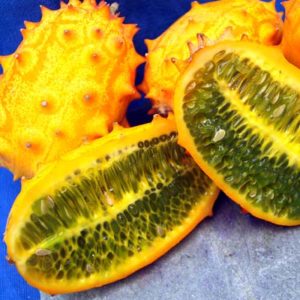Weird Veggies
May 14th, 2019
I’ve seen a lot of vegetables in my day, but while looking over the Baker Creek Heirloom Seeds catalog, one odd picture grabbed my eye.
It was a full-color shot of what looked like a fat, orange, warty, bloated cigar.
The plant was called a “jelly melon,” also known as the African horned cucumber, a vining crop native to Africa.
“The pulp inside resembles lime green Jell-O,” the catalog description read. “The fruit has a sweet-sour, banana-lime-tropical taste. Good juiced and sweetened.”
Sold.
Sucker that I am for anything new and different (and especially weird), I had to try growing jelly melon.
Turns out the jelly melon wasn’t all that great… sort of a seedy version of a soft cucumber.
But nonetheless, experimenting with such oddities is one of the best parts about growing your own edibles.
You can stick with the usual red tomatoes and green cucumbers if you want, but you also have the more adventurous option to grow just about anything you can get your seedy little hands on.
Grocery-store produce sections are offering way more choices than even a decade ago, but it’s still only scratching the surface of the possibilities.
For a few bucks’ investment, it’s doable to grow the world’s arguably tastiest watermelon (a variety called ‘Ali Baba’ from Iraq), a burgundy-leafed radicchio from Italy, a purple sweet potato, or a potato-like South American staple called jicama.
Not all of the off-the-beaten-path stuff works out, of course. Some of it just doesn’t like our climate or soil or the way you look at it.
But a big part of the fun is trying… just to see what’ll happen… just to find out what that jelly melon tastes like… just to see if the potato flesh really is blue like the picture.
Sometimes you hit something really cool and wonder why people don’t grow it more often.
Such was the case with the grape-sized little fruity thing that my York County Master-Gardener friend Dennis Mawhinney once gave me.
The fruit was oval and green-and-white striped, a spitting image of a watermelon that had gone into a shrink machine.
Dennis called it a “cucamelon” and said you eat the whole fruit – skin and all.
I tried one, and it was crunchy and tasted a lot like a cucumber, not like a watermelon.
That made sense since the cucamelon really is a vining annual that’s a cucumber-family member also called Mexican sour gherkin. It’s easy to grow from seed and very productive.
You’re more likely to find oddball offerings like this in seed packs as opposed to starter plants. Sniff around the garden-center seed racks, and if you’re not sufficiently mesmerized, order directly from the catalog companies.
Interested in stepping outside your comfort beds? Here are some other offbeat varieties I’ve tried and liked:
- Kohlrabi is an easy-to-grow cole crop that looks like something from another planet. It produces tennis-ball-sized orbs that sit just above the ground and send out leaf stems all around. ‘Superschmelz’ is a good green one, but you’ll also find purple varieties.
- Ramps are a type of wild, native onions that have an interesting mix of onion/garlic flavors. They’re a hot and trendy item lately on cutting-edge restaurant menus, but they’re easy to grow in the garden.
- ‘Ketchup ‘n Fries’ tomtato is a plant that has a tomato plant grafted onto the rootstock of a potato, giving you a frankenplant that produces tomatoes above ground and potatoes below ground.
- Carrots can be had in white, red-orange (‘Atomic Red’) and yellow (‘Yellowstone’), but especially interesting are the purple ones (‘Purple Haze,’ ‘Cosmic Purple’ and ‘Purple Dragon’).
- Parsnips and rutabagas are two old-fashioned root crops that are nutritious, cold-tolerant and long-keeping in storage. They’re best planted in summer to mature in fall.
- Gold-fleshed potatoes really caught on a few years ago when restaurants and gardeners discovered ‘Yukon Gold.’ Besides numerous golden choices, check out ‘All Blue,’ a small-tuber type with netted flesh of bluish-purple and white, or a purple-fleshed, purple-skinned fingerling variety called ‘Purple Majesty.’
- York County’s Landreth Seed carries an interesting collection of heirloom seeds, including some brought by slaves from Africa and the Caribbean. These include the ‘Fish Pepper’ (a very hot pepper originally used to season fish), and the ‘Georgia Rattlesnake’ watermelon (a large striped type dating to the 1830s).
- ‘Bulls Blood’ is an old red-beet variety with deep-burgundy leaves so colorful you can grow them in flower pots. ‘Chioggia’ has red-striped flesh that makes cut-open beets look like a bullseye.
- Lettuces are available in all sorts of shapes and colors, but don’t end your salad-bowl collection there. Try other interesting greens such as orach, corn salad, arugula, mizuna, and pak choi.
- I haven’t yet tried sunchokes (native-perennial sunflower tubers that are also called Jerusalem artichokes), but people tell me they have a sweet, nutty flavor.
Go ahead and experiment this season. Have fun.
Maybe you’ll even confuse the groundhogs.
Sources for some of the less-common vegetable varieties:
Baker Creek Heirloom Seeds. www.rareseeds.com, 417-924-8917.
- Landreth Seed Co. www.landrethseeds.com, 800-654-2407.
John Scheeper Kitchen Garden Seeds. www.kitchengardenseeds.com, 860-567-6086.
J.W. Jung Seed Co. www.jungseed.com, 800-247-5864.
Park Seed. www.parkseed.com, 800-845-3369.
Pinetree Garden Seeds. www.superseeds.com, 207-926-3400.
Renee’s Garden. www.reneesgarden.com, 888-880-7228.
Territorial Seed Co. www.territorialseed.com, 800-626-0866.
The Cook’s Garden. www.cooksgarden.com, 800-457-9703.
Tomato Growers Supply Co. www.tomatogrowers.com, 888-478-7333.
Totally Tomatoes. www.totallytomato.com, 800-345-5977.
W. Atlee Burpee Co. www.burpee.com, 800-888-1447.











